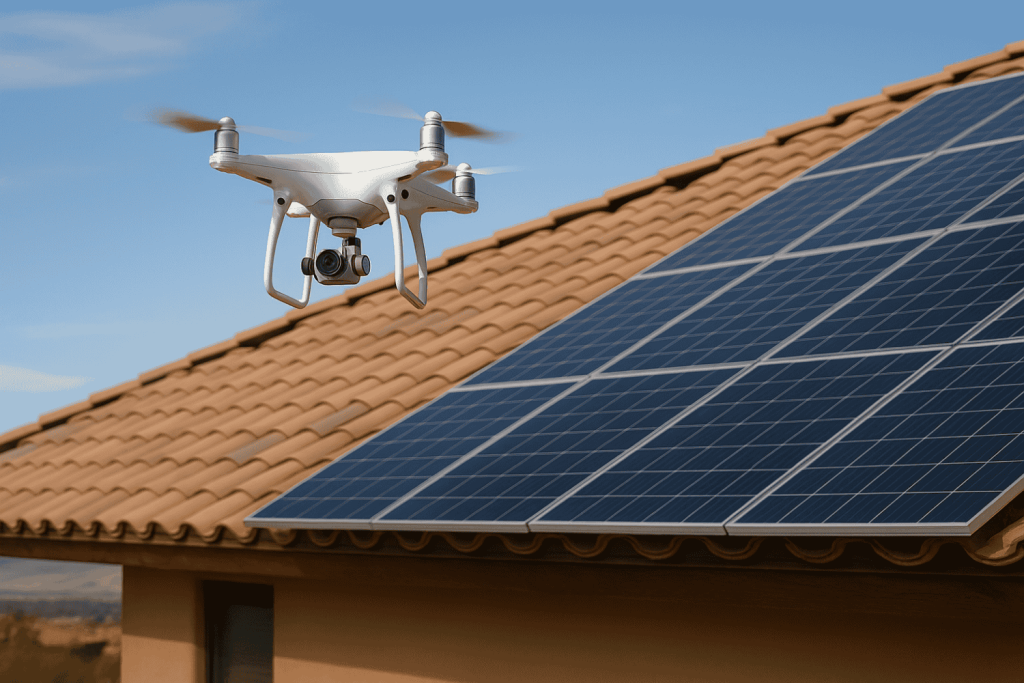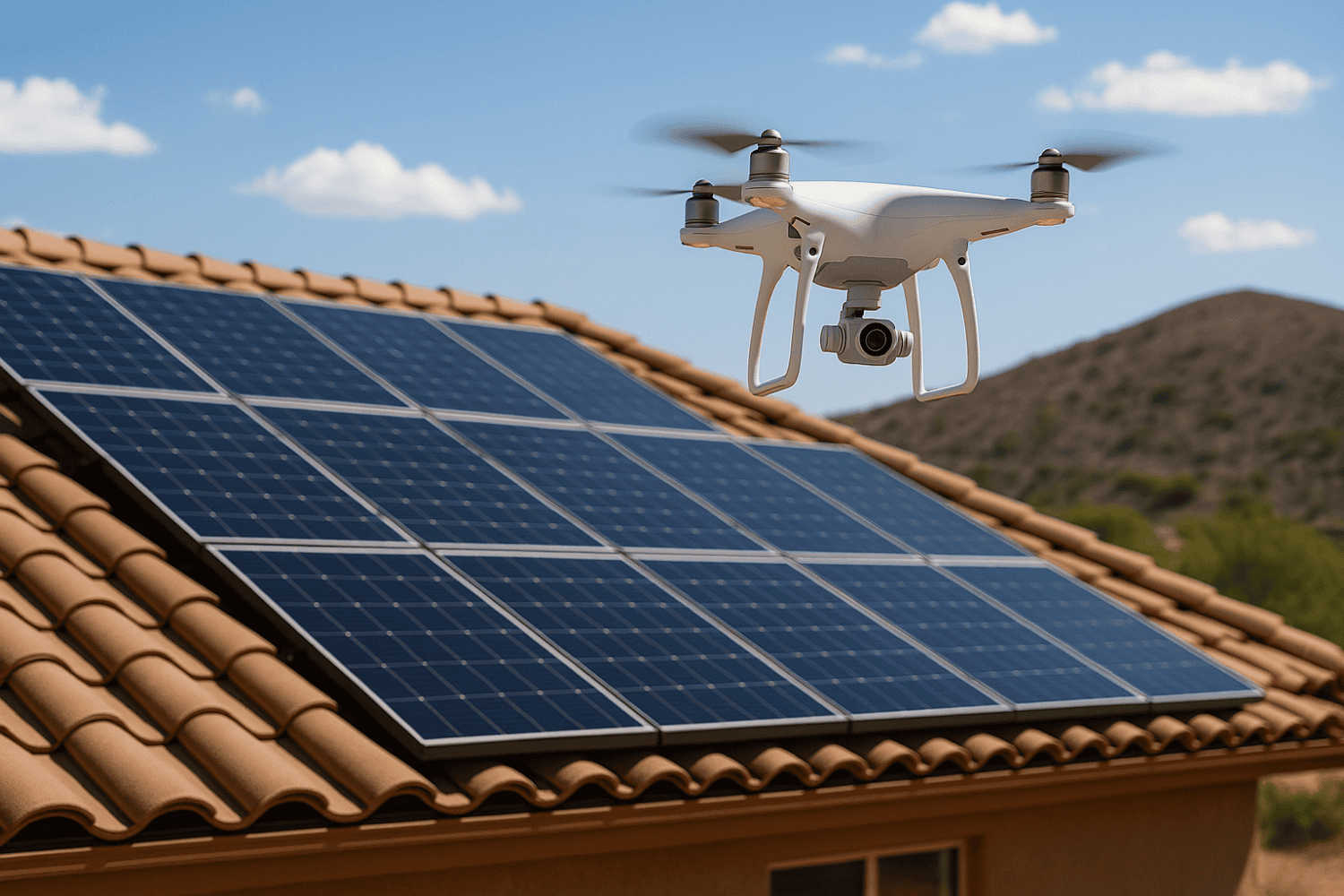In the scorching heat of the U.S. Southwest, climbing onto rooftops to inspect solar panels used to be a risky, time-consuming job, but today, drones equipped with high-resolution and thermal cameras are changing everything.
In fact, drone inspections can now cover massive solar arrays in a fraction of the time, sometimes up to 50 megawatts in a single day, without you ever stepping foot on a ladder.
As a home inspector with years of experience across sunbaked rooftops and dusty solar farms, I’ve seen firsthand how drones for solar panel inspection have transformed the way we work.
They make inspections faster, safer, and far more accurate, helping homeowners and solar operators catch problems early and keep their systems running at peak efficiency.
In this article, we’ll explore:
- What drones bring to solar inspections and why they’re superior to manual methods.
- The types of issues drones can detect, from cracked panels to hidden hotspots.
- How thermal imaging helps identify problems invisible to the naked eye.
- The time and cost savings that come with using drones.
- The tools and skills you need to get started with drone inspections.
By the end of this post, you’ll understand exactly how drones are revolutionizing solar panel inspections and how you can use them to boost safety, cut costs, and improve solar system performance.
Why Drones Make Solar Inspections Easier and Safer
In my years as a home inspector working across the sun-drenched rooftops and sprawling solar farms of the U.S. Southwest, one thing has become clear: safety and efficiency are everything.
Climbing steep roofs with a clipboard and camera in hand used to be the norm, but drones have changed all that. Today, drones for solar panel inspection are not only safer but also drastically more efficient and accurate.
Reaching Difficult Areas Without Climbing
- No need to walk on fragile rooftops, which reduces the risk of damaging shingles or solar panels.
- Inspections can be done from the ground, keeping inspectors safe and systems unharmed.
- Drones can hover and maneuver precisely over building-integrated solar panels or tight spaces.
Avoiding System Downtime
- No interruption to energy production, which means no loss in revenue.
- Real-time data collection lets you assess panel performance under actual working conditions.
- Maintenance decisions can be made without halting system operations.
Reducing Labor and Time
- Fewer personnel are needed, lowering labor costs.
- Automated flight paths allow for repeatable, consistent inspections.
- Results are available almost immediately, accelerating the decision-making process.
What Drones Look for During a Solar Inspection
Drones for solar panel inspection are equipped with high-resolution RGB and thermal cameras. These tools help detect a wide range of issues that affect solar performance.
Detecting Cracks and Broken Panels
- Cracks, chips, or shattered glass on panels.
- Misaligned or missing components.
- Discoloration or corrosion on panel surfaces.
These kinds of defects can reduce energy output and, if left unchecked, lead to more serious failures.
Spotting Hotspots With Thermal Imaging
- Hotspots can indicate failing cells, loose connections, or internal wiring problems.
- Thermal cameras, such as those from FLIR or Zenmuse, detect these issues before they cause panel failure.
- Identifying thermal anomalies early helps prevent DC losses and costly repairs.
Identifying Dust and Debris Buildup
- Drones can scan entire arrays to identify where buildup is concentrated.
- This data helps create targeted cleaning schedules, saving water and labor.
- Cleaner panels mean better energy performance and longer system life.

Tools and Technology Behind Drone Inspections
To get the most from drone inspections, you need the right equipment and software.
Camera Types and Sensor Payloads
- RGB (visual) cameras: Capture high-resolution images of the panels to identify physical damage.
- Thermal infrared cameras: Detect temperature differences that reveal electrical faults or hotspots.
Brands like FLIR and DJI’s Zenmuse line are trusted across the industry for their accuracy and reliability.
Flight Planning and GPS Mapping
- Pre-programmed routes ensure complete and repeatable coverage of each solar array.
- GPS coordinates help pinpoint the exact location of any fault, making repairs faster and more accurate.
- Real-time mapping helps operators monitor inspection progress and data collection as it happens.
AI and Real-Time Defect Detection
- AI algorithms scan images for anomalies like cracks, hotspots, or soiling.
- Immediate alerts allow inspectors to take action on critical issues right away.
- This reduces the need for manual image review and speeds up reporting.
How To Use Drone Data To Improve Solar Performance
Geo-Referenced Reports for Targeted Repairs
- Repair crews know exactly where to go and what to fix.
- No wasting time searching for a cracked panel across a 10-acre array.
- Reports can be shared digitally with maintenance teams, speeding up the workflow.
Tracking System Health Over Time
- Compare past and present data to spot deteriorating conditions.
- Identify recurring issues before they become serious problems.
- Use trend data to plan system upgrades or replacements.
Verifying Maintenance and Repairs
- Visual and thermal images show if hotspots are gone and panels are clean.
- This builds confidence in the repair process and ensures optimal performance.
- Helps validate warranty claims or service agreements.
Real-World Benefits I’ve Seen Firsthand
Saving Time on Large Rooftop Installs
On a recent commercial solar panel inspection job:
- We covered the entire roof without setting foot on it.
- The client had a full report with images and thermal maps by the next morning.
Finding Hidden Faults Missed by Manual Checks
A homeowner was experiencing reduced power generation and was unable to identify the cause.
- It turned out to be a failing cell that was slowly reducing output.
- The homeowner was able to replace the panel under warranty before it failed completely.
Helping Homeowners Avoid Expensive Repairs
For another homeowner experiencing loss of power:
- The drone scan showed exactly which panels were affected.
- A targeted cleaning brought the system back to full performance, saving hundreds in lost energy.
Drones for Solar Panel Inspection Are Shaping the Future
Drones for solar panel inspection have completely redefined how we maintain and optimize solar energy systems. From quickly spotting cracks and hotspots to generating precise, geo-referenced reports, drones bring unmatched speed, safety, and accuracy to the job.
With the right tools, like thermal cameras, GPS flight planning, and AI-powered defect detection, inspectors can cover more ground in less time and catch problems before they become costly failures.
As someone who’s spent years inspecting systems across the sunbaked rooftops and dusty solar farms of the Southwest, I can confidently say that drones aren’t just a convenience; they’re a game-changer.
Whether you’re a homeowner, solar technician, or asset manager, integrating drone inspections into your workflow will help you protect your investment and keep your solar array performing at its best.



